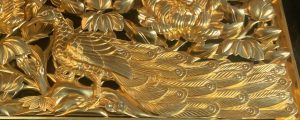
Among the exotic creatures you may find in a Jodo Shinshu Buddhist temple is a peacock.
At the Berkeley temple, for instance, peacocks appear in each of the three golden panels above the altar. Why do you suppose these birds take such prominence?

Peacocks are well known for their beautiful and colorful feathers, which they seemingly proudly display. But did you know that in India, peacocks are known to eat poisonous plants? They consume fruits, seeds, roots, and a variety of plants, but they’re omnivores, which means they’ll also eat insects, worms, small reptiles and amphibians. Among the creatures they find on the ground are snakes.
Peacocks have the ability to eat poisonous snakes. Some people believe this poison give peacocks’ feathers an especially bright sheen.
In Buddhism, snakes often symbolize anger, one of the Three Poisons of human nature. The other two are greed, symbolized by a rooster, and ignorance, symbolized by the pig. These three creatures are depicted in the center of the Tibetan Buddhist “Wheel of Life.”
All symbols in Buddhism are considered “expedient means” (Sanskrit: upaya), a way for us to more deeply understand ourselves and life. In a famous sermon at the end of his life, Shakyamuni Buddha told the parable of the “finger pointing to the moon,” in which he warned people not to focus on the finger, but to see the moon. Symbols are the finger pointing to the truth about ourselves (the moon).
From this perspective, peacocks represent the Buddha dharma, the teachings leading to understanding. The dharma can take our anger and transform it into something beautiful—compassion and understanding. That precious message is what the peacock is trying to tell us.
Next time you visit your local temple and see a peacock, try to hear what it has to say.
Related links:
Buddhist Symbols: Dragons, Serpents, Snakes
-Rev. Ken Yamada, editor, Shinshu Center of America

